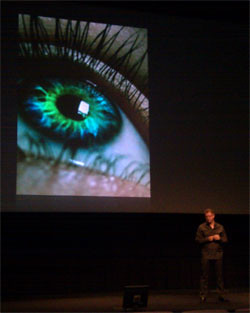Advertising Week ends with a look at how new technologies are impacting brand perceptions
 The final day of Toronto speakers at Advertising Week started off with James Stewart, Founder, Director and Producer at Canada’s Geneva Film Co. Stewart’s company has produced 3D ads for brands like Sprint and Lexus.
The final day of Toronto speakers at Advertising Week started off with James Stewart, Founder, Director and Producer at Canada’s Geneva Film Co. Stewart’s company has produced 3D ads for brands like Sprint and Lexus.
Stewart spoke about where advertising is headed as a result of the explosion of 3D screens in the market in the past year. Although 3D advertising is already pervasive on movie theatre screens (more so in the US than Canada), Stewart assured the audience that 3D advertising will absolutely take off on other screens in the next few years.
3D TV may seem like a slow moving market because only 6.5 Million 3D television sets were sold last year. However, Stewart said that the “adoption rate is still much faster than HD TV, which took 6 years to get to that number.” Almost every technological device now has a 3D screen coming out – from laptops to tablets and even out of home billboards.
Popular brands like Armani and Oakley are even jumping on the bandwagon and creating designer 3D glasses for consumers to carry around with them. Stewart explained that there are so many stakeholders involved in making 3D technology a success that the spend on 3D advertising will inevitably follow, despite the higher cost of production for 3D ads.
So, if 3D technology will soon be everywhere, you may be wondering how it will impact the way that brands tell stories to consumers. Stewart said that 3D is no longer a gimmick, “it’s just a more immersive storytelling tool.” In addition, Stewart said that this richer, more immersive experience of advertising shot in 3D has been proven to increase brand message retention rates. He explained that ESPN recently conducted a research study on their 3D TV audience during the World Cup. Stewart showed the results of the study which proved that the 3D viewing audience had a 15-16% lift in brand recall, purchase intent and brand likability over the 2D audience after being exposed to ads shown during the World Cup.
In the afternoon, Mitch Joel from Twist Image facilitated a panel discussion sponsored by AOL entitled “Beautifying the Internet: Original Content & Compelling Ads.” The discussion was once again focused on how digital media and new technology platforms have impacted the way advertising messages are now being told to consumers.
Mitch Joel opened up the panel discussion by asking “what constitutes good advertorial content?” Matt Straz, Co-founder and CMO of Pictela, a high definition content marketing platform that was recently acquired by AOL, said that “great advertising can actually be content if it’s done well.” He went on to say that “marketers have not been given the right tools to make it work to date.”
Joel then asked the panel to describe what the ideal “content marketing play looks like.” Ceri Marsh, Co-founder of Sweet Potato Chronicles, said that with new technology platforms like the iPad, it is becoming more of a thrill to develop digital content. She said that the “magazine industry is just learning how to make magazines live in the digital world.” She suggested that perhaps once the magazine industry figures out the right digital model, they may be able to develop a better way for consumers to enjoy ads that live alongside the editorial content online.
The panel agreed that the future of content marketing would involve tailoring your brand message to match the platform on which it is being displayed. Peter Vaz, VP of Digital at M2 Universal, said that “the way you view video on a tablet is quite different than how you view it on TV.” Vaz went on to say that we can expect to see “different versions and extensions of the same message on each digital platform” in the future.
Graham Moysey, General Manager at AOL Canada, argued that one of the biggest barriers to driving better content marketing experiences online is the industry trend to drive down CPMs (cost per thousand impressions). Matt Straz from Pictela explained that the industry currently wants to buy online media at a $1 CPM, while the true value of the content that they want in exchange is closer to a $50 to $100 CPM. Perhaps the compelling 3D experience discussed earlier in the day will have an impact on budgets in the future?
The other pricing-related challenge discussed was the fact that there is a ton of niche content online. However, it is currently hard to monetize that content due to low traffic volumes. Mitch Joel asked the panel what they thought would be the best monetization model that would scale across all of these niche websites? Matt Straz suggested that perhaps once a website’s traffic gets below a certain threshold, publishers should stop selling banner ads and just sell sponsorships.
The panel discussion ended with the argument that better metrics need to be in place to measure the impact of content marketing and brand storytelling online in the future. They said that the industry is still using traditional advertising metrics because there are no great brand advertising metrics for the web in place today.




